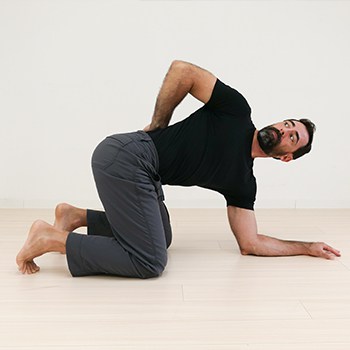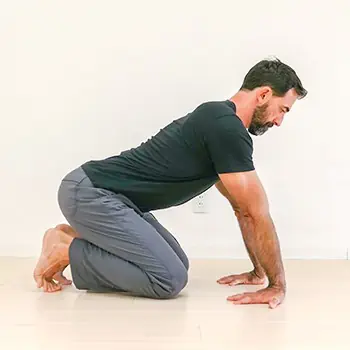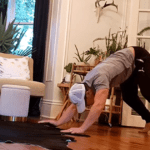Here’s pickle for you:
A lot of the most interesting jobs these days need you at your computer for hours every day. But then you look at people who’ve spent 10 or 20 years at a desk job…
→ Wrecked backs
→ Tight, rounded shoulders
→ Wrist and knee braces
And lots of stories about when they *used to* climb mountains and lift weights and generally have capable, pain-free bodies.
But the weirdest part?
We treat this as normal. As if ending up with a stiff, painful body that can’t do anything fun anymore is an acceptable outcome of making a living.
But it shouldn’t be.
Because not only can you prevent your body from getting tight, achy, and useless. You can get stronger, more flexible, and more capable than ever.
Even with a desk job.
Even if you’ve been slip-sliding into deskbod territory for years.
We’ve proven it with over 100,000 clients, many of them long-time desk jockeys. This article gives you the 3 key strategies they’ve used to do it.
First, though, we need to understand exactly why your desk job is torpedoing your body’s ability to move.

On a 15-minute break and no time to read the whole thing right now?
🎥 Watch our Hip Hacker video to debug your tightness right now
🛠 Skip to our top 3 strategies
📝 See a quick summary of our recommendations
Three Game Changing Stretches to Counter Being Deskbound
Why desk jobs are still hurting you (even though everyone knows it)
Companies spend millions of dollars on this problem so you’d think they’d have solved it by now… right?
But they can really only control what happens while you’re actually doing work. So they buy ergonomic keyboards and hire posture consultants.
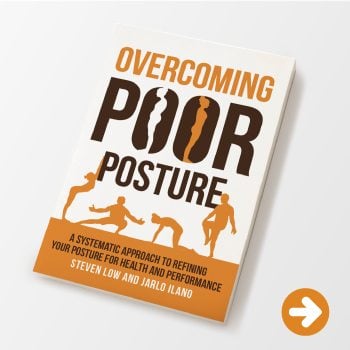
This book is filled with proven exercises to correct and improve your posture. Click here for details.
One of our founders even co-wrote a book to help you do it.
But if you’ve ever watched a company softball game, it’s embarrassing to witness just how much desk jobs still sap people’s performance over time.
The root cause is pretty simple:
You’re not getting enough movement and not enough variety of movement.
Which causes 4 key problems that tank your performance, health, and longevity:
- You get stiff and lose important ranges of motion.
- You lose strength.
- Your coordination and motor control suffer.
- Your overall health and longevity degrade.
 → Tight hips
→ Tight hips→ A stiff, painful back
→ Tight shoulders and neck
→ Strained wrists, hands, and forearms
Any one of these can sap your performance and cause pain. When you’re stiff it’s tough to move confidently without worrying that you’re gonna hurt yourself.
Strength is costly for your body to maintain. So the less you use it, the less of it you’ll have next time you want to run, jump, or lift something heavy.
But that’s not all it’s good for.
A strong body is also critical for stabilizing joints—from your spine to your ankles. So as you lose strength, your joint health often follows.
 Motor control is what makes complex movements like shooting a basketball feel effortless. It’s made up of things like spatial awareness, vestibular sense, cross-body coordination, timing, etc.
Motor control is what makes complex movements like shooting a basketball feel effortless. It’s made up of things like spatial awareness, vestibular sense, cross-body coordination, timing, etc.
Keeping all those things working together takes consistent, mindful movement most desk workers don’t get.
So things that used to feel “natural” start taking a lot more concentration and effort.
Lack of movement is linked to increased risk of musculoskeletal disorders, lowered insulin sensitivity, more chronic pain…
But here’s the rub: prolonged sitting has inertia.
Which means the more you do it, the harder it is to break the vicious cycle and get moving. And the higher your risk for all that stuff.
But it’s not all bad news…
Because the truth is that you can not only maintain your body’s health and capabilities. You can improve them, often dramatically—and you don’t even have to quit your desk job to do it.
Here are the 3 key strategies that’ll get you there.
Strategy #1: Keep a Consistent Physical Practice
This is number 1 for a reason. A consistent physical practice will do more for how your body feels and performs than all the supplements and cold plunges money can buy.
🧐 “But I already work out. So why am I still so stiff and sore from work?”
If you exercise consistently you’re already ahead of the game. But most workouts neglect important parts of an effective practice.
Here are 3 things a solid physical practice should include:
- Improves Your Strength, Flexibility, and Motor Control
- Progression and Cycling Built In
- Makes Room for Mindfulness and Adaptation
 Most workouts are pretty one-dimensional. You run. Or you lift. Or you HIIT.
Most workouts are pretty one-dimensional. You run. Or you lift. Or you HIIT.
If you stretch at all it’s just so you don’t get hurt in the moment.
But an effective practice will actively improve all 3 aspects of your athletic foundation.
Fitness marketing created the myth of the “complete” workout.
But it doesn’t exist. Everything has gaps and trade-offs.
It’s much more effective to follow a program that gets you concrete progress on what’s most important to you right now. Then cycle through your other goals in the same way.
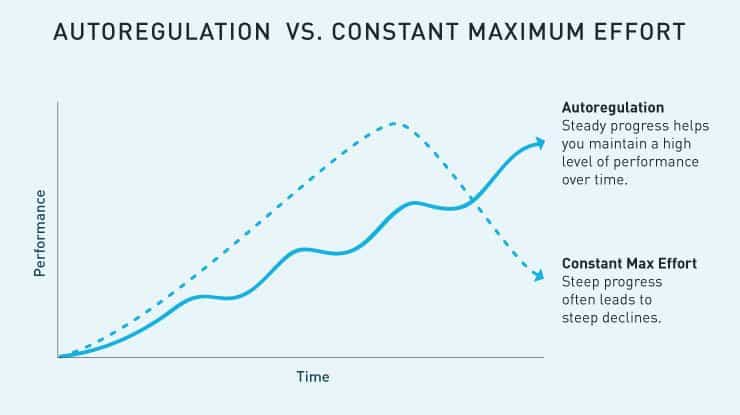 Gyms and fitness routines often push you to go your hardest, no matter what’s happening with your body. But paying close attention to your body’s feedback is how you learn what you actually need.
Gyms and fitness routines often push you to go your hardest, no matter what’s happening with your body. But paying close attention to your body’s feedback is how you learn what you actually need.
A good practice encourages you to notice and adapt to how you’re actually performing, so you don’t blow past your body’s boundaries into injury.
That might sound like a lot to keep in mind but if you follow a well-designed program, you don’t have to. It’s all in there for you.
We regularly hear from clients who just a week or two into our Elements program feel issues they’ve dealt with for years starting to resolve.
Our client Kamomi is a great example:
Her Elements practice not only reduced and resolved long-time pains, it was her springboard into a much more active life that includes a brand new martial arts practice.
Check it out: 👉 Kamomi: From Stiff to Strong
But if you’re super stiff or it’s been years since you exercised regularly, it can be tough to get started with a good physical practice.
In that case you want to add in the second strategy.
Strategy #2: Spot-Treat Areas of Acute Tightness or Restriction
Everyone’s starting point is different. So you might notice some limitations that get in the way of a new physical practice.
Tight hips. Weak wrists. Sore shoulders…
That’s very normal.
 The key is to identify which issue is holding you back the most. Then add in just enough supplemental training that you start to see it improve.
The key is to identify which issue is holding you back the most. Then add in just enough supplemental training that you start to see it improve.
Here are the supplemental routines we recommend most often for our clients with desk jobs:
Hips
This quick sequence has been used by millions of people to loosen tight hips and get moving better 👉 See the Routine
Shoulders
Get your shoulders moving through a full range of motion 👉 See the Routine (If you’re experiencing shoulder pain, start here instead.)
But even if you practice regularly, that’s probably only a few hours of movement per week. Which brings us to the third strategy…
Strategy #3: Get More Movement Throughout the Day
Recently there’s been a ton of research showing the health benefits of Non-Exercise Activity Thermogenesis, or NEAT. Which basically means all the movement you do outside of your training time.
 And at the risk of oversimplifying, the research says: More is better. (Up to a point of course.)
And at the risk of oversimplifying, the research says: More is better. (Up to a point of course.)
It helps reduce chronic pains and injuries, improves insulin sensitivity, and boosts longevity. But to get the full benefits you also need more movement variety. In other words:
- More walking = Good
- More walking, squatting, hanging, and crawling = Better
🧐 “Well if I had time for that I wouldn’t be reading this, would I?”
You’ve got more important things to do than spend hours every week moving for the sake of moving. But getting more movement doesn’t always have to take more time.
Here are a few of our favorite ways to add movement to your day that won’t add hours to your schedule:
- Regularly shift between sitting to standing/walking: Switching it up just once every hour was shown to decrease the risk of musculoskeletal disorders (like low back injuries) up to 30%.
- Do some desk stretches: Loosen up your shoulders, back, and hips without ever leaving your desk with this quick routine.
- Practice balance walking: It improves your full-body coordination. But it doesn’t even have to be on an elevated surface like a curb. Start with painted lines or cracks in the ground.
- Do chores on the floor: Folding clothes or sorting the mail? Do it sitting on the floor. Find positions where you can keep your back straight. And for bonus points…
- Play with different ways to stand up: Try to find as many different ways as you can. Get weird. Have fun with it.

But you’re busy, so we went ahead and put together dozens of movement ideas for you that don’t cost much (if any) extra time:
See all 57 ways 👉 Move More, Move Better
Start by finding one or two that’ll work for you and make them a regular part of your day.
The benefits way outstrip the effort.
Fix your deskbod and get moving your very best
The only way your desk job becomes a life sentence to stiffness and incapacity is if you choose to do nothing.
So don’t do nothing!
Our desk-jockey clients who got their stiff, achey bodies moving better than ever all used these strategies:
Basic Recommendations:
- Start a consistent physical practice
- Spot-treat areas of acute tightness or restriction
- Get more movement throughout the day
But if you’re just getting started you don’t have to do them all at once.
Just do what you can.
When you’re ready to make the most progress in the time you have, the best way to do that is with a practice like our Elements program.
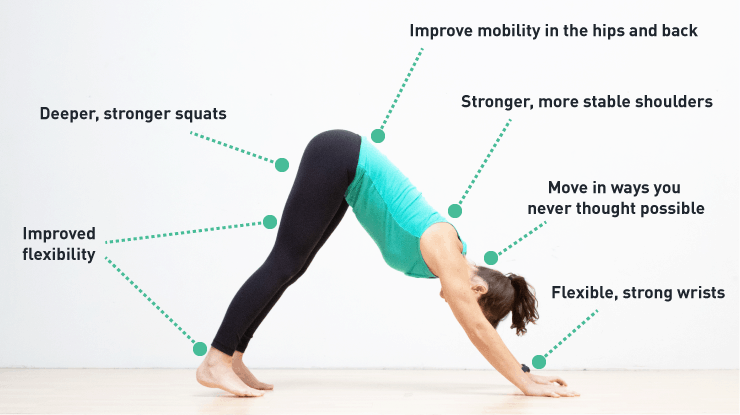 It walks you through our proven process to reduce the tightness and aches of desk work, while at the same time getting you stronger and more coordinated for all the activities you enjoy.
It walks you through our proven process to reduce the tightness and aches of desk work, while at the same time getting you stronger and more coordinated for all the activities you enjoy.
It’s a secret weapon not just for keeping your body from going downhill, but to actively feel and move better without giving up your laptop job.
You can see all the details below:
Trade “Deskbod” for Strong, Agile, and Resilient
Elements is the online program thousands of desk workers use to feel and perform better in the activities they enjoy.



